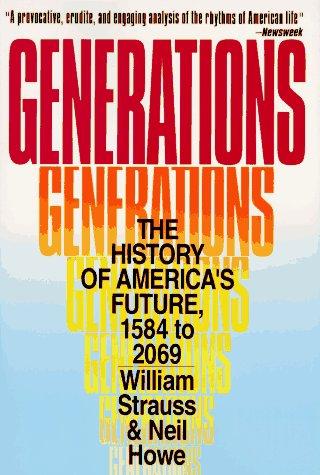538 pages
English language
Published Dec. 24, 1991 by Quill.

538 pages
English language
Published Dec. 24, 1991 by Quill.
William Strauss and Neil Howe’s partnership began in the late 1980s when they began writing their first book Generations, which tells the history of America as a succession of generational biographies going back to 1584. Each had written on generational topics [...] The authors’ interest in generations as a broader topic emerged after they met in Washington, D.C., and began discussing the connections between each of their previous work.
They wondered why Boomers and G.I.s had developed such different ways of looking at the world, and what it was about these generations’ growing up experiences that prompted their different outlooks. They also wondered whether any previous generations had acted along similar lines, and their research showed that there were indeed historical analogues to the current generations. The two ultimately identified a recurring pattern in Anglo-American history of four generational types, each with a distinct collective persona, and a corresponding cycle …
William Strauss and Neil Howe’s partnership began in the late 1980s when they began writing their first book Generations, which tells the history of America as a succession of generational biographies going back to 1584. Each had written on generational topics [...] The authors’ interest in generations as a broader topic emerged after they met in Washington, D.C., and began discussing the connections between each of their previous work.
They wondered why Boomers and G.I.s had developed such different ways of looking at the world, and what it was about these generations’ growing up experiences that prompted their different outlooks. They also wondered whether any previous generations had acted along similar lines, and their research showed that there were indeed historical analogues to the current generations. The two ultimately identified a recurring pattern in Anglo-American history of four generational types, each with a distinct collective persona, and a corresponding cycle of four different types of era, each with a distinct mood. The groundwork for this theory was laid out in Generations in 1991. Strauss and Howe expanded on the theory and updated the terminology in The Fourth Turning in 1997.
Generations helped popularize the idea that people in a particular age group tend to share a distinct set of beliefs, attitudes, values and behaviors because they all grow up and come of age during a particular period in history. In the mid-1990s, the authors began receiving inquiries about how their generational insights could help solve strategic problems in organizations. Strauss and Howe were quickly established as pioneers in a growing field, and started speaking frequently about their work at events and conferences. [excerpted from Wikipedia, Strauss–Howe generational theory]